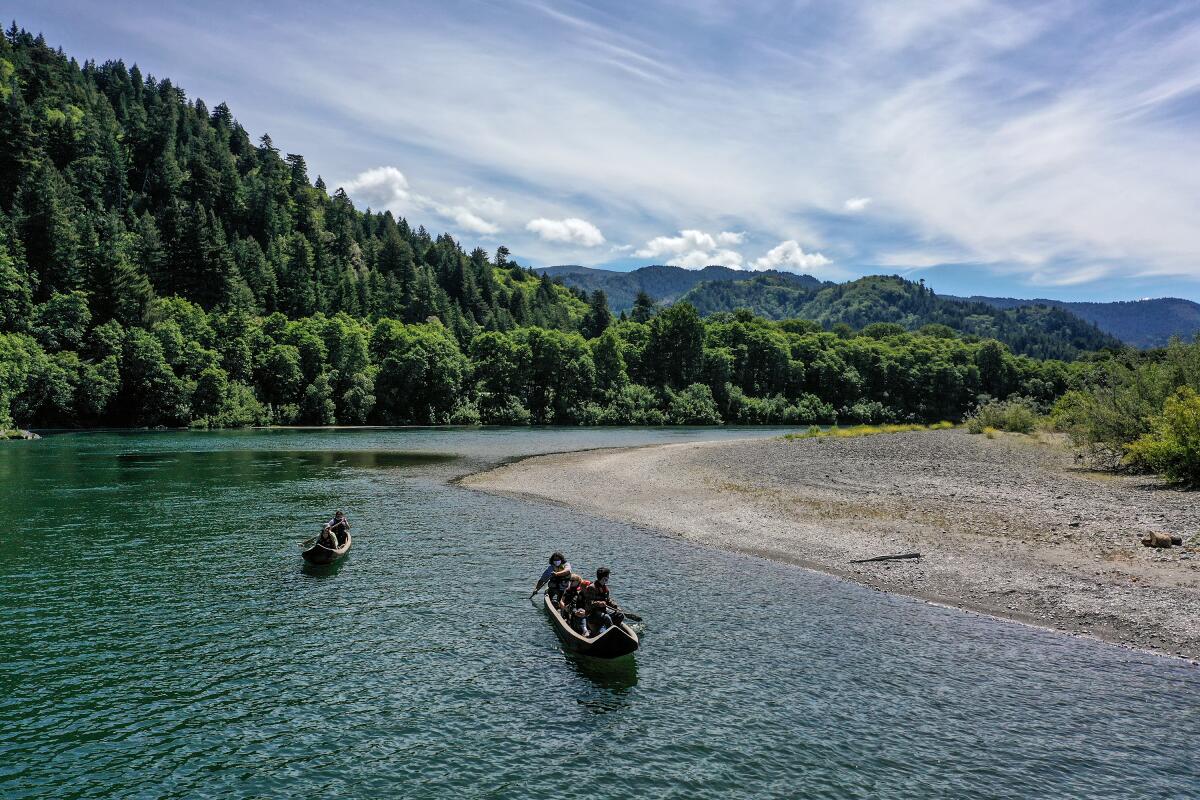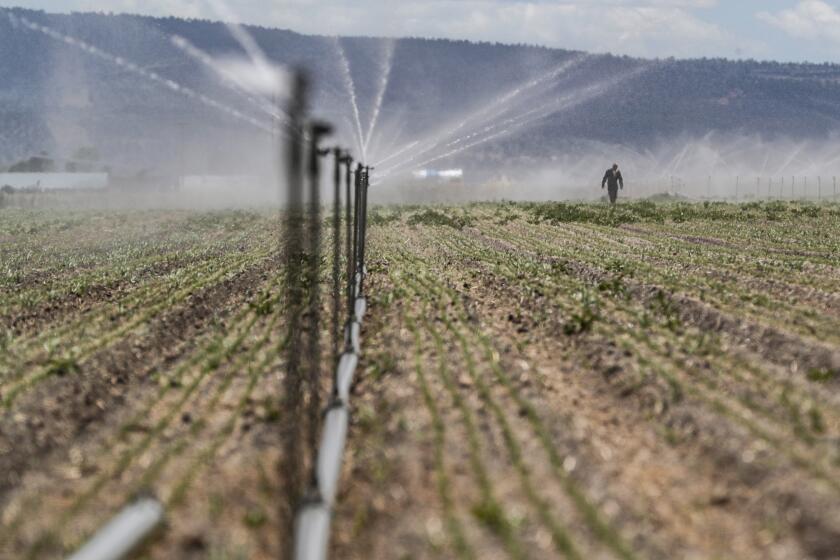As drought persists, government says Klamath farmers will be allocated limited water

- Share via
As severe drought persists in Northern California and southern Oregon, the federal Bureau of Reclamation announced Monday that farmers and ranchers will be allocated a limited amount of water in the Klamath River Basin this summer.
Water is at the center of bitter disputes between growers, the federal government and tribes over how much should be allocated for food production, flows in the Klamath River and the health of threatened fish.
Federal water managers said the initial allocation on the Klamath Project will be about 50,000 acre-feet to allow for limited irrigation from April to mid-July. That’s more than last year but less than 15% of the full allocation that federal officials say could be delivered for agriculture during times when there is sufficient water.
The bureau also announced $20 million in drought-response aid, which will provide relief to growers who can’t irrigate crops, and an additional $5 million for projects led by the six tribes in the Klamath Basin.
“We wish we had better news today. Obviously, there are no winners in this critical year as all interests are suffering — fisheries, farmers, tribes and waterfowl alike,” said Ernest Conant, the agency’s regional director. “But given the current hydrology that we have to work with, we did the best job we could, working in collaboration with our federal partners, to apply the resources that we have.”
Water held in Upper Klamath Lake in southern Oregon flows through federally built canals to fields of alfalfa, potatoes and other crops. These water deliveries through the Klamath Project have been cut back during dry years, which are being intensified by global warming.
“It’s a very low allocation in light of the very dismal hydrology that we have,” Conant said.
Some tribal leaders said the government’s decision would send far too much water flowing through canals, to the detriment of two kinds of endangered suckerfish that hold cultural importance for their tribes.
Clayton Dumont, a member of the Klamath Tribes’ Council, said he and other leaders are deeply disappointed.
“We’re angry. We believe that our fish that were guaranteed to us in the treaty with the United States are getting short shrift. We’re clearly last in line,” Dumont said. “We think that the Endangered Species Act is pretty clear that the species should be put first. We don’t think that’s what’s happening.”
Dumont said the ecosystem has undergone long-term degradation since the Bureau of Reclamation began diverting water and changing the watershed.
“What we’ve arrived at now is really the end of a long, long process that has resulted in problems for many species, not just our fish,” Dumont said. “We think that the water needs to be there to take care of the threatened and endangered fish.”
Disputes over water deliveries have stirred conflict between the government, farmers and irrigation districts. And federal officials warned that any unauthorized diversions of water would bring consequences.
“Unauthorized diversions of water will result in reductions in the Klamath Project water allocation and appropriate legal action,” Conant told reporters. He said officials are “hoping that irrigators will cooperate with us, and adaptively manage the limited supply that we have.”
Last year, the bureau initially allocated 33,000 acre-feet of water but said much of that was consumed through unauthorized diversions. The agency cited the severe drought in shutting down the Klamath Project’s main A Canal and delivering no water during the 2021 irrigation season.
The aid for growers who don’t plant crops will be available only for agricultural irrigation districts that adhere to the plan, Conant said. If some don’t cooperate, he added, “they will compromise their ability to receive drought relief funding.”
The water allocation announcement came after growers who belong to the Klamath Irrigation District voted on March 29 for the district to “pursue all available avenues which are legal, moral, and ethical to acquire and deliver irrigation water” despite any “objections, threats, intimidation, or language from outside agencies.”
The Klamath Water Users Assn., which counts the irrigation district among its members, said in a statement that voters “did not advocate unlawful action” and that farmers and ranchers in the area are “disappointed and mystified by the disconnect between global food security concerns and policies that deprive them of the water they want and need in order to produce food.”
“Today, a toxic atmosphere of distrust and division pervades the Klamath Basin,” the water users association said. It said the irrigation district and the federal government “have differing views regarding the scope of federal discretion and authority” over water infrastructure that the district has operated for nearly 70 years.
The vote was condemned by the Klamath Tribes, whose leaders said it shows the irrigation district “plans to increase its ongoing, illegal diversions.”
“We remain incensed by the United States’ failure to enforce its own law,” the tribe’s leaders said in a statement. “We have to wonder what would happen if, as Native people, we engaged in such blatantly unlawful action?”
Black Lives Matter has emboldened a younger generation of the Klamath Tribes, who are now speaking out on their treatment on the parched Oregon-California border.
Conant said he hopes irrigation districts “will work with us” to ensure that the level of Upper Klamath Lake is maintained above key thresholds this year.
The initial water allocation is based on current conditions in the watershed. If the drought were to ease, the allocation to farmers could increase.
“The Klamath Basin is experiencing prolonged and extreme drought conditions that we have not seen since the 1930s,” acting Reclamation Commissioner David Palumbo said in a statement. He said the bureau will continue to monitor water conditions and adapt while coordinating with water users, tribes and other agencies.
The Bureau of Reclamation also plans to release a “flushing flow” in the Klamath River in the coming days to help protect salmon from disease, Conant said.
Six tribal nations in the Klamath Basin — Hoopa Valley, Yurok, Karuk, Resighini Rancheria, Quartz Valley Tribes and the Klamath Tribes — will be eligible to receive $5 million from the government in technical assistance.
“The tribes will presumably use it for a variety of programs, some water conservation measures, some additional monitoring, some additional water use programs, some educational programs,” said Brian Person, an advisor with the Bureau of Reclamation. “The decision is up to them, of course.”
More to Read
Sign up for Essential California
The most important California stories and recommendations in your inbox every morning.
You may occasionally receive promotional content from the Los Angeles Times.












